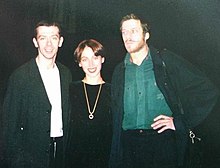Alexei Ratmansky

Alexei Ratmansky , Russian Алексей Осипович Ратманский , transcription Alexei Ossipowitsch Ratmanski, (born August 27, 1968 in Leningrad ) is a Russian dancer and choreographer who is known for reconstructing and staging ballet productions and versions of the 19th and early 20th centuries.
Ratmansky was trained as a dancer at the Ballet Academy of the Bolshoi Theater in Moscow. He was first soloist with the Ukrainian National Ballet , the Royal Winnipeg Ballet and the Den Kongelige Ballet . He started choreographing while still an active dancer.
As a choreographer he worked for the Mariinsky Ballet in Saint Petersburg, the Paris Opera Ballet , the Royal Ballet , the Den Kongelige Ballet, the Royal Swedish Ballet, the New York City Ballet , the National Ballet of the Netherlands, the American Ballet Theater and the San Francisco Ballet .
From 2004 to 2008 he was artistic director of the Bolshoi Ballet in Moscow. For this he created the ballet pieces The Bright Stream (2003), The Bolt (2005) and Lost Illusions (2011). He created choreographies for the dancers Nino Ananiaschwili , Wendy Wheelan , Diana Viktorovna Vishnyova and for Mikhail Baryshnikov . His Concerto DSCH from 2008 is a ballet based on Shostakovich's second piano concerto .
From 2009 he has been artist in residence with the American Ballet Theater in New York.
He is known for reconstructions of old ballet productions, such as Le Corsaire (2007), Flames of Paris (2008, premiered in 1932 in Leningrad with the choreography by Vasili Vainonen , music by Boris Vladimirovich Assafiev , based on the chants of the French Revolution), Paquita von Marius Petipa (2014, Bavarian State Opera) and Swan Lake by Petipa and Lev Iwanow (2016, Zurich Opera House, Scala), using the Stepanov notation stored at Harvard University (Houghton Library) ( Sergejew Collection ) . The choreographer of the Imperial Russian Ballet in Saint Petersburg Sergeyev brought the collection to the USA in 1918 after the Russian Revolution, where it has been at Harvard since 1969.
He received the Golden Mask four times (1998, 2004, 2007, 2010), in 2005 the Prix Benois de la Danse (for Anna Karenina ), in 2006 the Dmitry Shostakovich Prize and the London Critics Circle Award, he received the Bessie Award and in 2011 the Dance Magazine Award. In 2011 he became a knight of the Danish Order of Danebrog .
Web links
References and comments
- ↑ Originally premiered in Paris in 1846, choreographed by Joseph Mazilier , music by Édouard Deldevez , Ludwig Minkus , choreographed by Petipa in Moscow in 1847, Petipa's first production in Russia.
| personal data | |
|---|---|
| SURNAME | Ratmansky, Alexei |
| ALTERNATIVE NAMES | Ratmansky, Alexei Osipovich |
| BRIEF DESCRIPTION | Russian dancer and choreographer |
| DATE OF BIRTH | August 27, 1968 |
| PLACE OF BIRTH | St. Petersburg |